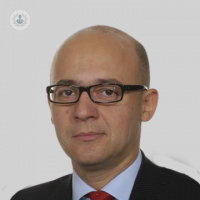Gallstones increasingly common problem
Escrito por:In the UK, around 1 in 6-10 adults have gallstones and around 60,000 cholecystectomies are performed yearly. Anecdotal evidence suggests that the number of patients presenting with symptomatic gallstones is increasing and the severity of the disease is more significant compared with the previous 10-20 years.
Mr Radu Mihai is a top consultant surgeon who specialises in treating gallstones. He explains exactly why gallstones form and the various health problems that can arise if they aren’t treated.

What are gallstones?
Your gallbladder is a small organ situated on the right side of the abdomen, just under the liver. It acts as a reservoir for bile, a liquid formed by the liver and needed for digestion of fatty foods. In between meals, most of the bile accumulates in the gallbladder and is released through contractions of the gallbladder wall when fatty foods arrive in the stomach. A change in the chemistry of the bile allows cholesterol crystals to accumulate and join together into small ‘stones’.
Gallstones can range in size from as small as a grain of sand to as large as a golf ball. Some people develop just one gallstone but many gallstones are more likely.
What problems can arise from gallstones?
- Asymptomatic gallstones — Many people have gallstones that cause no symptoms or complications and are diagnosed during a routine ultrasound for other abdominal conditions. The majority of them remain asymptomatic and require no treatment. Incidental finding of an isolated gallstone in a normal gallbladder does not need immediate referral or treatment if it is confirmed that in the preceding 12 months there were no gallstones-related symptoms. Progression from asymptomatic to symptomatic disease is expected in up to 25% over 10 years. The longer the patients remain asymptomatic, the less likely they are to develop symptoms. It is unlikely, but not impossible, to develop severe, potentially life-threatening complications, for example, cholangitis or severe acute pancreatitis without first having at least one episode of biliary pain.
- Biliary colic — Repeated episodes of upper abdominal/right upper abdominal pain exacerbated by eating are most likely related to biliary colic, a common symptom triggered by gallstones. Further episodes of biliary pain can be prevented in around 30% of patients by adopting a low-fat diet and avoiding food and drinks known to trigger such symptoms.
- Cholecystitis — Inflammation of the gallbladder leads to exacerbation of symptoms and development of fever (with or without rigours). Some episodes can be controlled with oral antibiotics but often patients need a referral for emergency surgical admission. The usual approach is to offer early laparoscopic cholecystectomy that should be carried out within one week of diagnosis.
- Gallbladder empyema — A build-up of pus in the gallbladder as a result of a blocked cystic duct is a surgical emergency. The options for treatment are between removing the gallbladder as an emergency operation and percutaneous cholecystostomy - a radiological procedure to drain pus and fluid from the infected gallbladder using a drain introduced under radiological guidance.
- Jaundice – if a small gallstone migrates from the gallbladder into the common bile duct, it blocks the flow of bile from the liver into the gut and triggers a rise in the bilirubin levels in the blood - hence the change to the yellow colour of the eyes and skin. This is a medical emergency and needs urgent removal of the stones from the bile duct through a procedure called ERCP (endoscopic retrograde cholangiopancreatography).
- Acute pancreatitis – This is a very serious complication of gallstones with the potential of being life-threatening. It is caused by the migration of a stone into the common bile duct leading to obstruction of the pancreatic duct.
When is surgical treatment necessary for gallstones?
There is no evidence of benefit from non-surgical treatments such as gallstone dissolution therapies (ursodeoxycholic acid) or extracorporeal lithotripsy. The definitive treatment of symptomatic gallbladder stones is the surgical removal of the gallbladder.
Patients with persistent or frequent episodes of biliary colic are unlikely to settle on conservative management (i.e. low-fat diet and avoidance of some foods). Therefore, they should be referred to discuss gallstones surgery.
All patients admitted with acute cholecystitis are being considered for early surgery unless they have severe medical problems that would increase the risks associated with anaesthesia and surgery.
All other complications of gallstones are a strong indication for surgery but the timing of the operation varies according to individual factors that will be discussed with you by the team in charge of your care.
In Mr Radu Mihai’s upcoming article, he will discuss how gallstone removal surgery is performed, what the potential risks and complications are and how to care for yourself following the operation.
To book an appointment with Mr Radu Mihai, visit his Top Doctors profile and check his next availability.


